Microstructural Study of a Mg–Zn–Zr Alloy Hot Compressed at a High Strain Rate
Abstract
1. Introduction
2. Experimental Procedures
3. Results
3.1. As-Forged Microstructure
3.2. OM Characterization of the Compressed Microstructures
3.3. EBSD Characterizations of the Compressed Microstructures
3.3.1. Grain Average Misorientation Analysis of Global Microstructures
3.3.2. Texture and Misorientation Analysis of Different Groups of Grains
3.3.3. Analysis of the Deformation/DRX Mechanisms of Zr-Rich Coarse Grains
4. Discussion
4.1. Post-DRX (PDRX) after the Hot Compression
- (1)
- For a given strain level of −0.40, the size of the grown equiaxed grains in the sample deformed at of 10 s−1 was larger than the DRXed grains in the sample deformed at of 10−3 s−1 (Figure 7). In terms of a well-established theory that a higher strain rate leads to finer DRXed grains, it is unlikely that the grown equiaxed grains were produced during the high-strain-rate deformation. Moreover, the GAM values of the grown equiaxed grains at of 10 s−1 (Figure 7c) were lower than those of the DRXed grains at of 10−3 s−1 (Figure 7b). Therefore, it is reasonable to believe that the grown equiaxed grains were from static recrystallization (SRX) after the hot deformation ceased, owing to the quench delay in the present study. The growth of DRXed nucleus probably happened in the interval between the end of compression and water quenching (~4–5 s). Considering that DRX softening was initiated at the true strain of −0.17 (Figure 2b), the equiaxed grains with large size were more likely from the growth of the DRX nucleus produced during the hot compression. This is consistent with the phenomenon of meta-dynamic recrystallization (MDRX) [41,42,43], which is a type of PDRX. MDRX tends to be triggered during hot deformation conducted at a high strain rate. Dislocation density and stored strain energy increase with strain rate at a given temperature and for a given strain level, which provides the driving force for the growth of the DRXed nucleus [44].
- (2)
- The fraction of the grown equiaxed grains with a GAM value < 0.35° in the high-strain-rate deformed sample at εt of −1.11 (Figure 8d) was much lower than that of the samples deformed under the same condition but at lower strains (Figure 8b,c). Stored strain energy was released via DRX in the sample deformed to εt of −1.11. Therefore, the driving force for PDRX/MDRX was significantly reduced.
- (3)
- The grown equiaxed grains existed in the Zr-lean domains while the grains residing in the Zr-rich domains retained a refined size. The dispersion of Zn–Zr precipitates retarded grain boundary migration; thereby, the growth of the DRX nucleus formed in the Zr-rich domains was impeded. Therefore, the PDRX phenomenon could only be observed in the Zr-lean domains.
4.2. Microstructural Evolution of ZK30 during Hot Compression
4.3. Plasticity of ZK30 during Hot Compression at of 10 s−1
- (1)
- Severe shear banding related to geometrical softening caused by the formation of compression twinning and double twinning in the basal-textured matrix was impeded. This is because twinning was suppressed due to the refined grain size and high testing temperature.
- (2)
- The dominant DRX mechanisms operating in the present study were CDRX and DDRX via boundary corrugation (Figure 12 and Figure 13). DRXed grains produced via these mechanisms tended to have similar orientations as their parent grains. Although they coalesced to form a necklace structure around the coarse grains, strains were not concentrated in the necklace structure to form shear bands. This is because the DRXed grains in the necklace structure had similar Schmid factors for slip as the parent grains.
- (3)
- It is believed that Zr-rich coarse grains played an essential role in accommodating plastic strains during the hot compression at of 10 s−1. It was observed that coarse grains in the macro-SBs gradually undertook more plastic strain with straining. Since the distribution of Zr-rich coarse grains was relatively homogeneous in the macro-SBs, deformation within the macro-SBs was homogenized and thereby, good plasticity of the as-forged ZK30 alloy was achieved. Referring to Figure 12 and Figure 13, prismatic slip was activated in the Zr-rich coarse grains. Non-basal slip activity contributed to the operation of CDRX in the vicinity of Zr-rich coarse grains, leading to the relaxation of stress concentration at the interphase. In addition, the activated non-basal slip enhanced the plasticity of Zr-rich coarse grains by providing more independent deformation mechanisms.
5. Conclusions
- The PDRX phenomenon was observed in the Zr-lean regions of the ZK30 samples hot deformed to true strains ranging from −0.22 to −0.69 at a strain rate of 10 s−1. The experimental results suggested that the DRXed nucleus produced during the hot compression grew into the matrix of high stored strain energy after the deformation ceased. However, for the sample deformed to a true strain of −1.11 at the same strain rate, stored strain energy was significantly released by profuse DRX and hence, PDRX behavior was impeded.
- A true strain of −1.11 can be achieved during the hot compression of the as-forged ZK30 alloy at a temperature of 350 °C and a strain rate of 10 s−1, without any cracks observed. The alloy exhibited excellent formability under the present deformation condition.
- During the hot deformation at a strain rate of 10 s−1, a macro-shear band started to form at a true strain of −0.22, and plastic strains localized to it with the deformation continued. Within the shear band, a ‘necklace structure’ consisting of refined DRXed grains was formed around the Zr-rich coarse grains. CDRX and DDRX via grain boundary corrugation/bulging were the dominant recrystallization mechanisms. As the deformation continued, the fraction of refined DRXed grains in the Zr-rich domains increased and the aspect ratio of coarse grains dramatically increased. In contrast, the microstructure after hot compression at a strain rate of 10−3 s−1 under the same temperature was much more uniform for the same strain level.
- Zr-rich coarse grains, which were homogeneously distributed in the as-received microstructure, played an important role in accommodating plastic strains in the hot deformation at a high strain rate. It is speculated that the densely distributed Zn–Zr particles of refined size reduced the ratio of the critical resolved shear stress of the prismatic slip to that of the basal slip. This contributed to the activation of prismatic slips enhancing the plasticity of coarse grains. Moreover, the high activity of prismatic slips facilitated the operation of CDRX in the vicinity of grain boundaries, which effectively relaxed the stress concentration.
- The present study suggests that the twinning-induced DRX mechanism is not necessary for the excellent plasticity of Mg alloys in hot deformation under a high-strain-rate condition. Enhanced activity of non-basal slips appears to be more essential to improve the plasticity of Mg alloys hot deformed at a high strain rate.
Author Contributions
Funding
Conflicts of Interest
References
- Luo, A.A. Magnesium: Current and potential automotive applications. JOM 2002, 54, 42–48. [Google Scholar] [CrossRef]
- You, S.; Huang, Y.; Kainer, K.U.; Hort, N. Recent research and developments on wrought magnesium alloys. J. Magnes. Alloys 2017, 5, 239–253. [Google Scholar] [CrossRef]
- Luo, A.A. Magnesium casting technology for structural applications. J. Magnes. Alloys 2013, 1, 2–22. [Google Scholar] [CrossRef]
- Zhang, Z.; Yan, Z.; Du, Y.; Zhang, G.; Zhu, J.; Ren, L.; Wang, Y. Hot deformation behavior of homogenized Mg-13.5 Gd-3.2 Y-2.3 Zn-0.5 Zr alloy via hot compression tests. Materials 2018, 11, 2282. [Google Scholar] [CrossRef]
- Quan, G.Z.; Ku, T.W.; Song, W.J.; Kang, B.S. The workability evaluation of wrought AZ80 magnesium alloy in hot compression. Mater. Des. 2011, 32, 2462–2468. [Google Scholar] [CrossRef]
- Prasad, Y.; Rao, K. Effect of homogenization on the hot deformation behavior of cast AZ31 magnesium alloy. Mater. Des. 2009, 30, 3723–3730. [Google Scholar] [CrossRef]
- Kim, H.; Lee, J.; Lee, C.; Bang, W.; Ahn, S.; Chang, Y. Shear band formation during hot compression of AZ31 Mg alloy sheets. Mater. Sci. Eng. A 2012, 558, 431–438. [Google Scholar] [CrossRef]
- Jin, X.; Xu, W.; Shan, D.; Liu, C.; Zhang, Q. Deformation behavior, microstructure evolution and hot workability of Mg-3.7 Gd-2.9 Y-0.7 Zn-0.7 Zr alloy. Met. Mater. Int. 2017, 23, 434–443. [Google Scholar] [CrossRef]
- Rao, K.; Prasad, Y.; Suresh, K.; Hort, N.; Kainer, K. Hot deformation behavior of Mg–2Sn–2Ca alloy in as-cast condition and after homogenization. Mater. Sci. Eng. A 2012, 552, 444–450. [Google Scholar] [CrossRef]
- Xiao, H.; Jiang, S.; Tang, B.; Hao, W.; Gao, Y.; Chen, Z.; Liu, C. Hot deformation and dynamic recrystallization behaviors of Mg–Gd–Y–Zr alloy. Mater. Sci. Eng. A 2015, 628, 311–318. [Google Scholar] [CrossRef]
- Lentz, M.; Risse, M.; Schaefer, N.; Reimers, W.; Beyerlein, I. Strength and ductility with {10−11}-{10−12} double twinning in a magnesium alloy. Nat. Commun. 2016, 7, 1–7. [Google Scholar] [CrossRef]
- Dogan, E.; Vaughan, M.; Wang, S.; Karaman, I.; Proust, G. Role of starting texture and deformation modes on low-temperature shear formability and shear localization of Mg–3Al–1Zn alloy. Acta Mater. 2015, 89, 408–422. [Google Scholar] [CrossRef]
- Sun, D.; Chang, C. Microstructural study of strain localization in a compressed Mg–3Al–1Zn alloy. Mater. Sci. Eng. A 2014, 603, 30–36. [Google Scholar] [CrossRef]
- Sandlöbes, S.; Zaefferer, S.; Schestakow, I.; Yi, S.; Gonzalez-Martinez, R. On the role of non-basal deformation mechanisms for the ductility of Mg and Mg–Y alloys. Acta Mater. 2011, 59, 429–439. [Google Scholar] [CrossRef]
- Vaughan, M.; Nasim, W.; Dogan, E.; Herrington, J.; Proust, G.; Benzerga, A.; Karaman, I. Interplay between the effects of deformation mechanisms and dynamic recrystallization on the failure of Mg-3Al-1Zn. Acta Mater. 2019, 168, 448–472. [Google Scholar] [CrossRef]
- Jiang, L.; Jonas, J.J.; Mishra, R.; Luo, A.; Sachdev, A.; Godet, S. Twinning and texture development in two Mg alloys subjected to loading along three different strain paths. Acta Mater. 2007, 55, 3899–3910. [Google Scholar] [CrossRef]
- Zhu, S.; Yan, H.; Chen, J.; Wu, Y.; Liu, J.; Tian, J. Effect of twinning and dynamic recrystallization on the high strain rate rolling process. Scr. Mater. 2010, 63, 985–988. [Google Scholar] [CrossRef]
- Zhu, S.; Ringer, S.P. On the role of twinning and stacking faults on the crystal plasticity and grain refinement in magnesium alloys. Acta Mater. 2018, 144, 365–375. [Google Scholar] [CrossRef]
- Zhu, S.; Yan, H.; Liao, X.; Moody, S.; Sha, G.; Wu, Y.; Ringer, S. Mechanisms for enhanced plasticity in magnesium alloys. Acta Mater. 2015, 82, 344–355. [Google Scholar] [CrossRef]
- Lentz, M.; Behringer, A.; Fahrenson, C.; Beyerlein, I.J.; Reimers, W. Grain size effects on primary, secondary, and tertiary twin development in Mg-4 wt pct Li (-1 wt pct Al) alloys. Metall. Mater. Trans. A 2014, 45, 4737–4741. [Google Scholar] [CrossRef]
- Rafailov, G.; Caspi, E.a.N.; Hielscher, R.; Tiferet, E.; Schneck, R.; Vogel, S.C. Visualization of texture components using MTEX. J. Appl. Crystallogr. 2020, 53, 540–548. [Google Scholar] [CrossRef] [PubMed]
- Li, J.; Barrirero, J.; Sha, G.; Aboulfadl, H.; Mücklich, F.; Schumacher, P. Precipitation hardening of an Mg–5Zn–2Gd–0.4 Zr (wt.%) alloy. Acta Mater. 2016, 108, 207–218. [Google Scholar] [CrossRef]
- Mendis, C.; Oh-Ishi, K.; Kawamura, Y.; Honma, T.; Kamado, S.; Hono, K. Precipitation-hardenable Mg–2.4 Zn–0.1 Ag–0.1 Ca–0.16 Zr (at.%) wrought magnesium alloy. Acta Mater. 2009, 57, 749–760. [Google Scholar]
- Sha, G.; Zhu, H.; Liu, J.; Luo, C.; Liu, Z.; Ringer, S. Hydrogen-induced decomposition of Zr-rich cores in an Mg− 6Zn− 0.6 Zr− 0.5 Cu alloy. Acta Mater. 2012, 60, 5615–5625. [Google Scholar] [CrossRef]
- Hadadzadeh, A.; Mokdad, F.; Amirkhiz, B.S.; Wells, M.; Williams, B.W.; Chen, D. Bimodal grain microstructure development during hot compression of a cast-homogenized Mg-Zn-Zr alloy. Mater. Sci. Eng. A 2018, 724, 421–430. [Google Scholar] [CrossRef]
- Wright, S.I.; Nowell, M.M.; Field, D.P. A review of strain analysis using electron backscatter diffraction. Microsc. Microanal. 2011, 17, 316–329. [Google Scholar] [CrossRef]
- Wright, S.I.; Suzuki, S.; Nowell, M.M. In situ EBSD observations of the evolution in crystallographic orientation with deformation. JOM 2016, 68, 2730–2736. [Google Scholar] [CrossRef]
- Yoda, R.; Yokomaku, T.; Tsuji, N. Plastic deformation and creep damage evaluations of type 316 austenitic stainless steels by EBSD. Mater. Charact. 2010, 61, 913–922. [Google Scholar] [CrossRef]
- Rui, S.-S.; Shang, Y.-B.; Fan, Y.-N.; Han, Q.-N.; Niu, L.-S.; Shi, H.-J.; Hashimoto, K.; Komai, N. EBSD analysis of creep deformation induced grain lattice distortion: A new method for creep damage evaluation of austenitic stainless steels. Mater. Sci. Eng. A 2018, 733, 329–337. [Google Scholar] [CrossRef]
- Feng, A.H.; Ma, Z.Y. Microstructural evolution of cast Mg-Al-Zn during friction stir processing and subsequent aging. Acta Mater. 2009, 57, 4248–4260. [Google Scholar] [CrossRef]
- Jiang, M.G.; Xu, C.; Yan, H.; Fan, G.H.; Nakata, T.; Lao, C.S.; Chen, R.S.; Kamado, S.; Han, E.H.; Lu, B.H. Unveiling the formation of basal texture variations based on twinning and dynamic recrystallization in AZ31 magnesium alloy during extrusion. Acta Mater. 2018, 157, 53–71. [Google Scholar] [CrossRef]
- Sakai, T.; Belyakov, A.; Kaibyshev, R.; Miura, H.; Jonas, J.J. Dynamic and post-dynamic recrystallization under hot, cold and severe plastic deformation conditions. Prog. Mater. Sci. 2014, 60, 130–207. [Google Scholar] [CrossRef]
- Sitdikov, O.; Kaibyshev, R. Dynamic recrystallization in pure magnesium. Mater. Trans. 2001, 42, 1928–1937. [Google Scholar] [CrossRef]
- Eleti, R.R.; Chokshi, A.H.; Shibata, A.; Tsuji, N. Unique high-temperature deformation dominated by grain boundary sliding in heterogeneous necklace structure formed by dynamic recrystallization in HfNbTaTiZr BCC refractory high entropy alloy. Acta Mater. 2020, 183, 64–77. [Google Scholar] [CrossRef]
- Huang, K.; Logé, R. A review of dynamic recrystallization phenomena in metallic materials. Mater. Des. 2016, 111, 548–574. [Google Scholar] [CrossRef]
- Cruz-Gandarilla, F.; Bolmaro, R.; Mendoza-León, H.; Salcedo-Garrido, A.; Cabañas-moreno, J. Study of recovery and first recrystallisation kinetics in CGO Fe3% Si steels using misorientation-derived parameters (EBSD). J. Microsc. 2019, 275, 133–148. [Google Scholar] [CrossRef] [PubMed]
- Solas, D.E.; Tome, C.N.; Engler, O.; Wenk, H.R. Deformation and recrystallization of hexagonal metals: Modeling and experimental results for zinc. Acta Mater. 2001, 49, 3791–3801. [Google Scholar] [CrossRef]
- Lassila, D.H.; Leblanc, M.M.; Florando, J.N. Zinc single-crystal deformation experiments using a “6 degrees of freedom” apparatus. Metall. Mater. Trans. A 2007, 38a, 2024–2032. [Google Scholar] [CrossRef]
- Yan, C.K.; Feng, A.H.; Qu, S.J.; Cao, G.J.; Sun, J.L.; Shen, J.; Chen, D.L. Dynamic recrystallization of titanium: Effect of pre-activated twinning at cryogenic temperature. Acta Mater. 2018, 154, 311–324. [Google Scholar] [CrossRef]
- Galiyev, A.; Kaibyshev, R.; Sakai, T. Continuous dynamic recrystallization magnesium alloy. Mater. Sci. Forum 2003, 419–422, 509–514. [Google Scholar] [CrossRef]
- Sakai, T.; Ohashi, M.; Chiba, K.; Jonas, J. Recovery and recrystallization of polycrystalline nickel after hot working. Acta Metall. 1988, 36, 1781–1790. [Google Scholar] [CrossRef]
- Djaic, R.P.; Jonas, J. Recrystallization of high carbon steel between intervals of high temperature deformation. Metall. Trans. 1973, 4, 621–624. [Google Scholar] [CrossRef]
- Petkovic, R.; Luton, M.; Jonas, J. Recovery and recrystallization of polycrystalline copper after hot working. Acta Metall. 1979, 27, 1633–1648. [Google Scholar] [CrossRef]
- Nicolaÿ, A.; Fiorucci, G.; Franchet, J.; Cormier, J.; Bozzolo, N. Influence of strain rate on subsolvus dynamic and post-dynamic recrystallization kinetics of Inconel 718. Acta Mater. 2019, 174, 406–417. [Google Scholar] [CrossRef]
- Robson, J.; Paa-Rai, C. The interaction of grain refinement and ageing in magnesium–zinc–zirconium (ZK) alloys. Acta Mater. 2015, 95, 10–19. [Google Scholar] [CrossRef]
- Bhattacharyya, J.; Sasaki, T.; Nakata, T.; Hono, K.; Kamado, S.; Agnew, S. Determining the strength of GP zones in Mg alloy AXM10304, both parallel and perpendicular to the zone. Acta Mater. 2019, 171, 231–239. [Google Scholar] [CrossRef]
- Chapuis, A.; Driver, J.H. Temperature dependency of slip and twinning in plane strain compressed magnesium single crystals. Acta Mater. 2011, 59, 1986–1994. [Google Scholar] [CrossRef]
- Nie, J.F. Effects of precipitate shape and orientation on dispersion strengthening in magnesium alloys. Scr. Mater. 2003, 48, 1009–1015. [Google Scholar] [CrossRef]
- Chaudry, U.M.; Hamad, K.; Kim, J.-G. Ca-induced Plasticity in Magnesium Alloy: EBSD Measurements and VPSC Calculations. Crystals 2020, 10, 67. [Google Scholar] [CrossRef]
- Masood Chaudry, U.; Hoo Kim, T.; Duck Park, S.; Sik Kim, Y.; Hamad, K.; Kim, J.-G. On the high formability of AZ31-0.5 Ca magnesium alloy. Materials 2018, 11, 2201. [Google Scholar] [CrossRef]
- Sánchez-Martín, R.; Pérez-Prado, M.; Segurado, J.; Bohlen, J.; Gutiérrez-Urrutia, I.; Llorca, J.; Molina-Aldareguia, J. Measuring the critical resolved shear stresses in Mg alloys by instrumented nanoindentation. Acta Mater. 2014, 71, 283–292. [Google Scholar] [CrossRef]
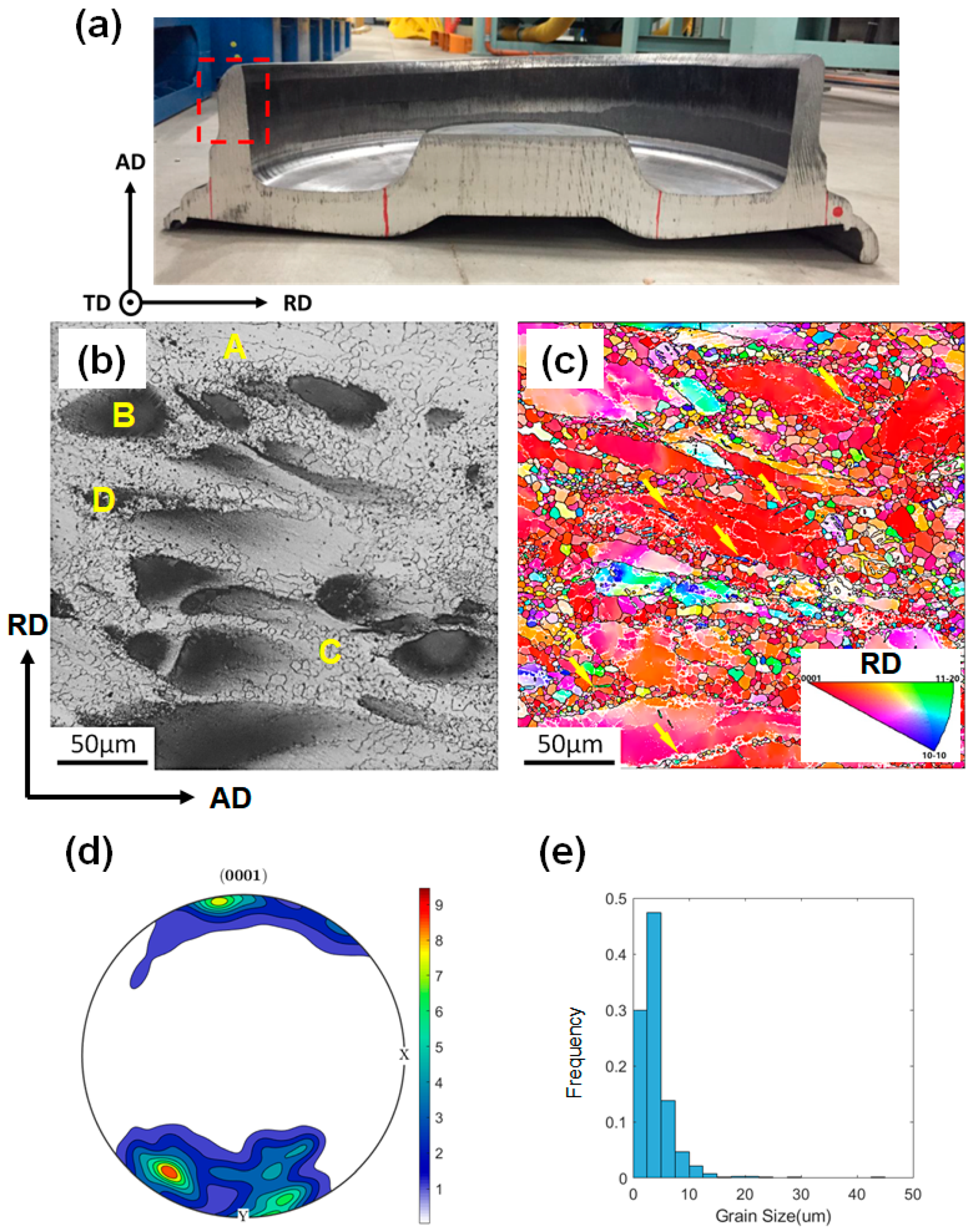
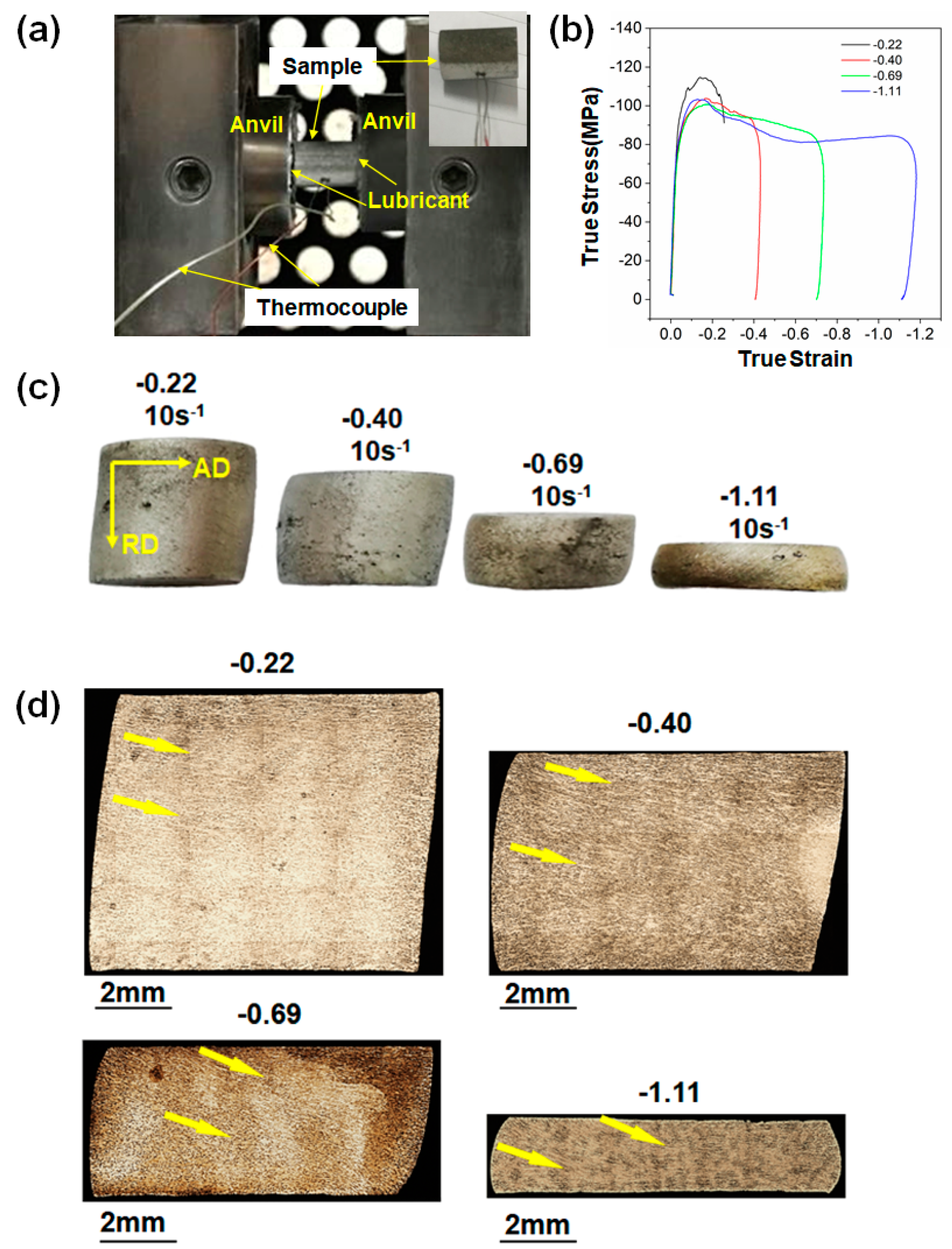
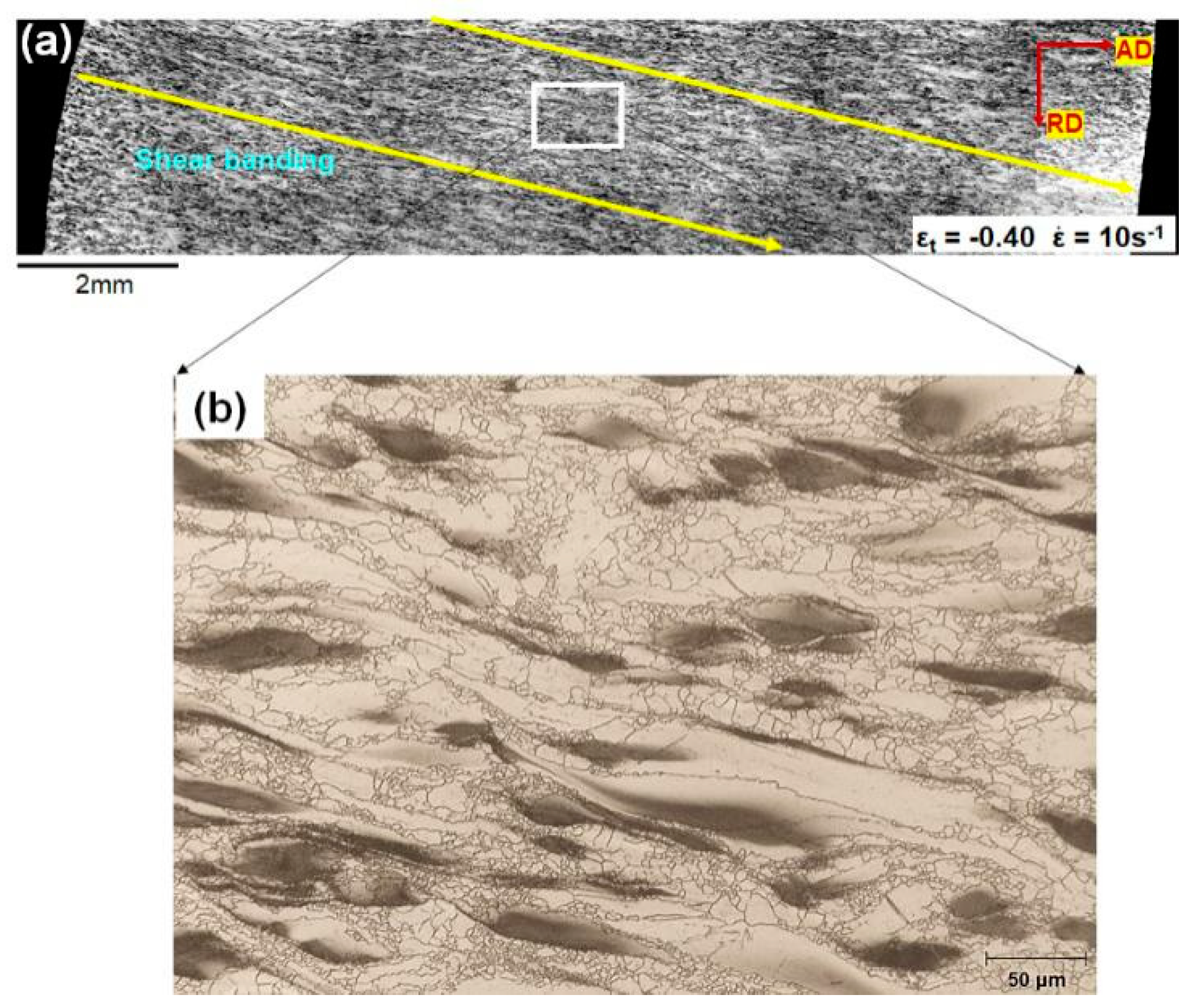
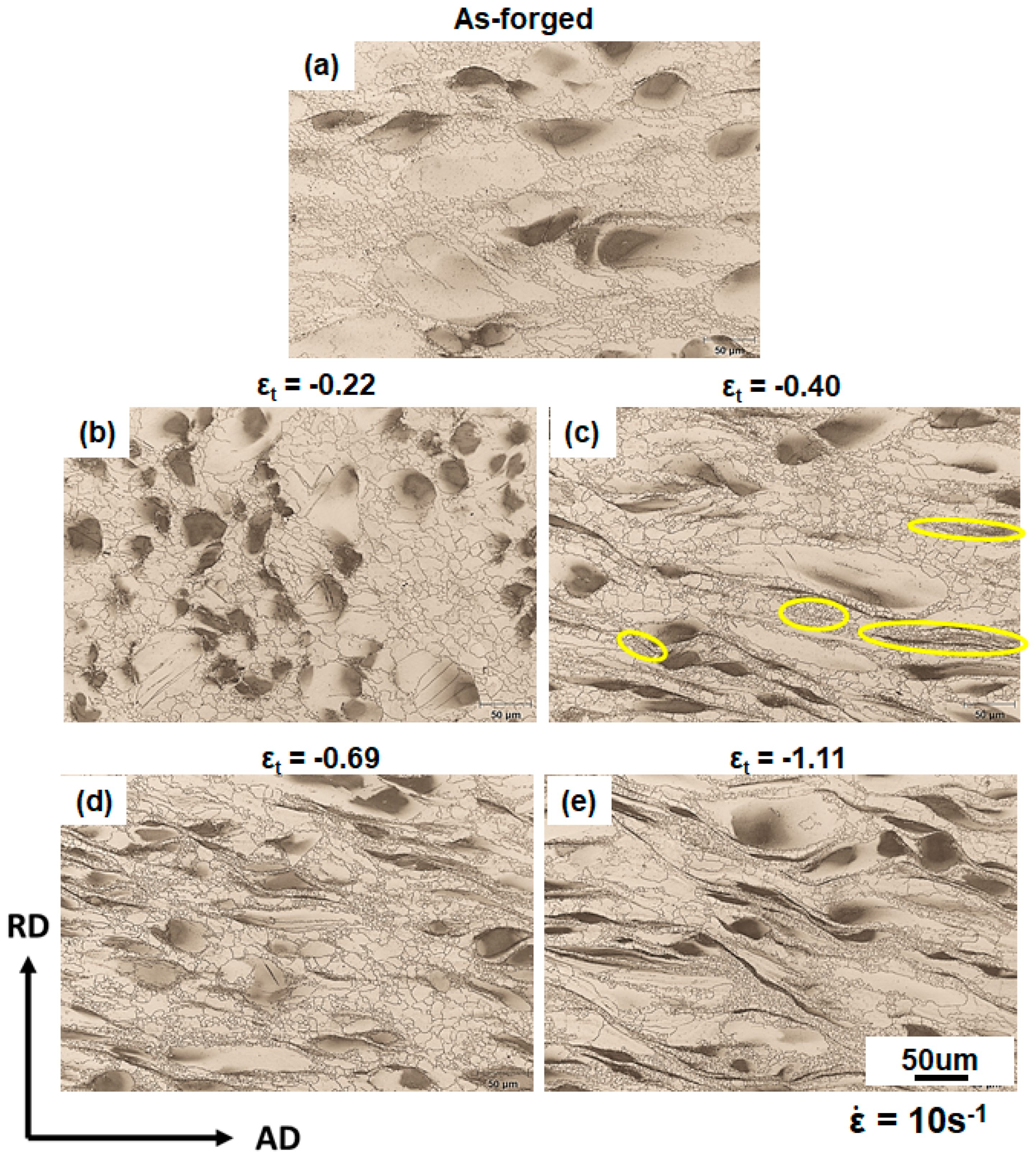
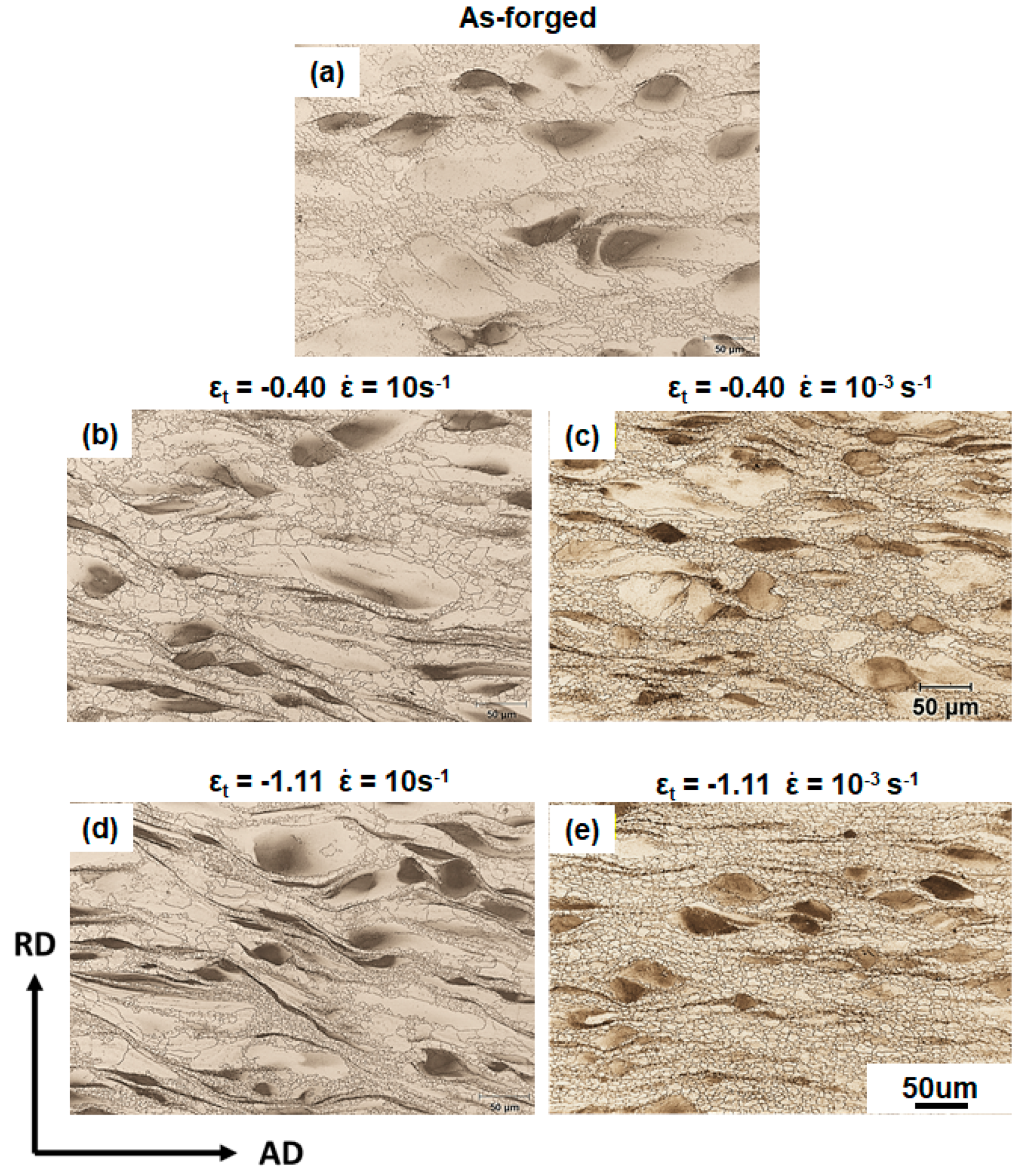
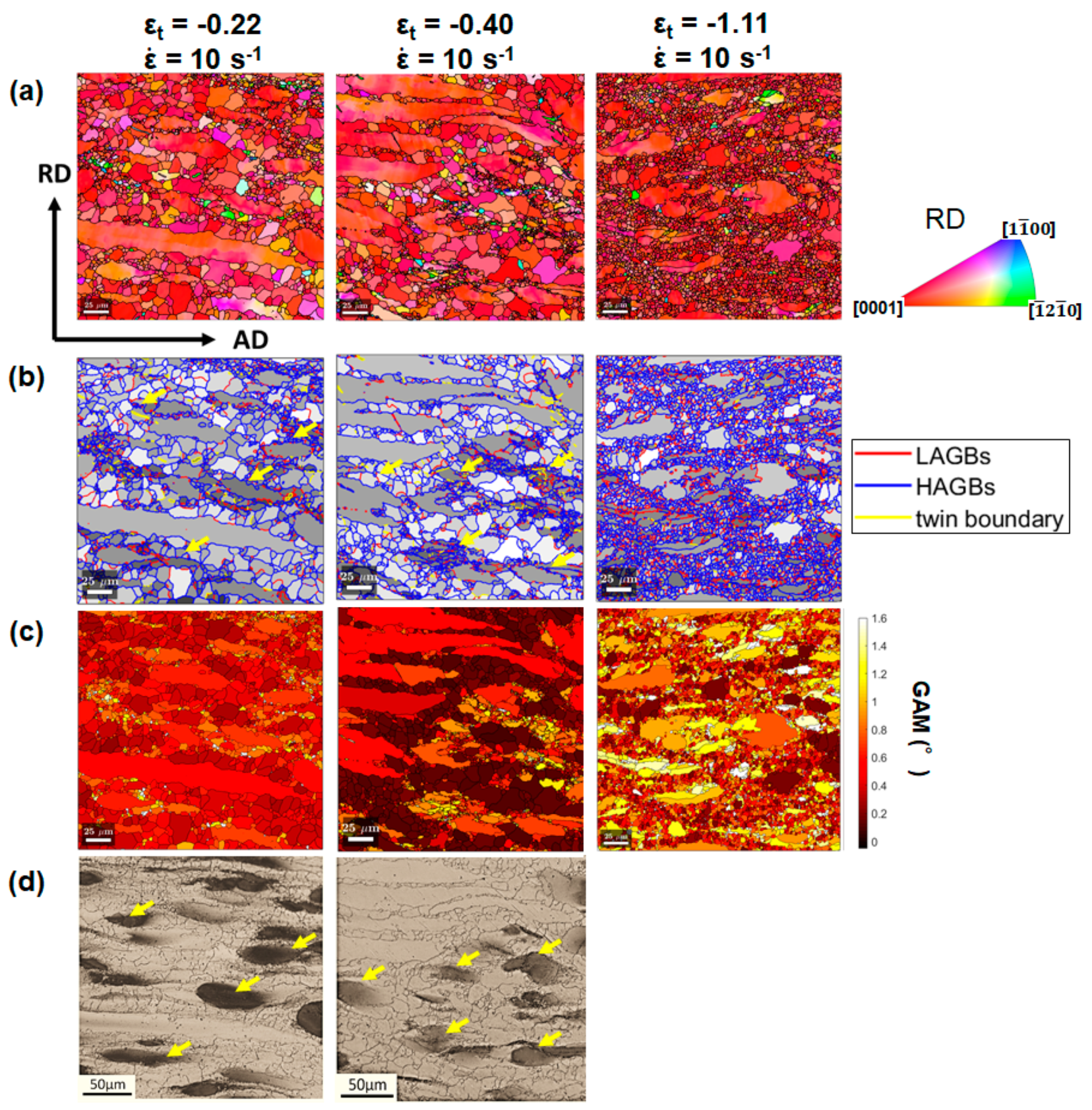
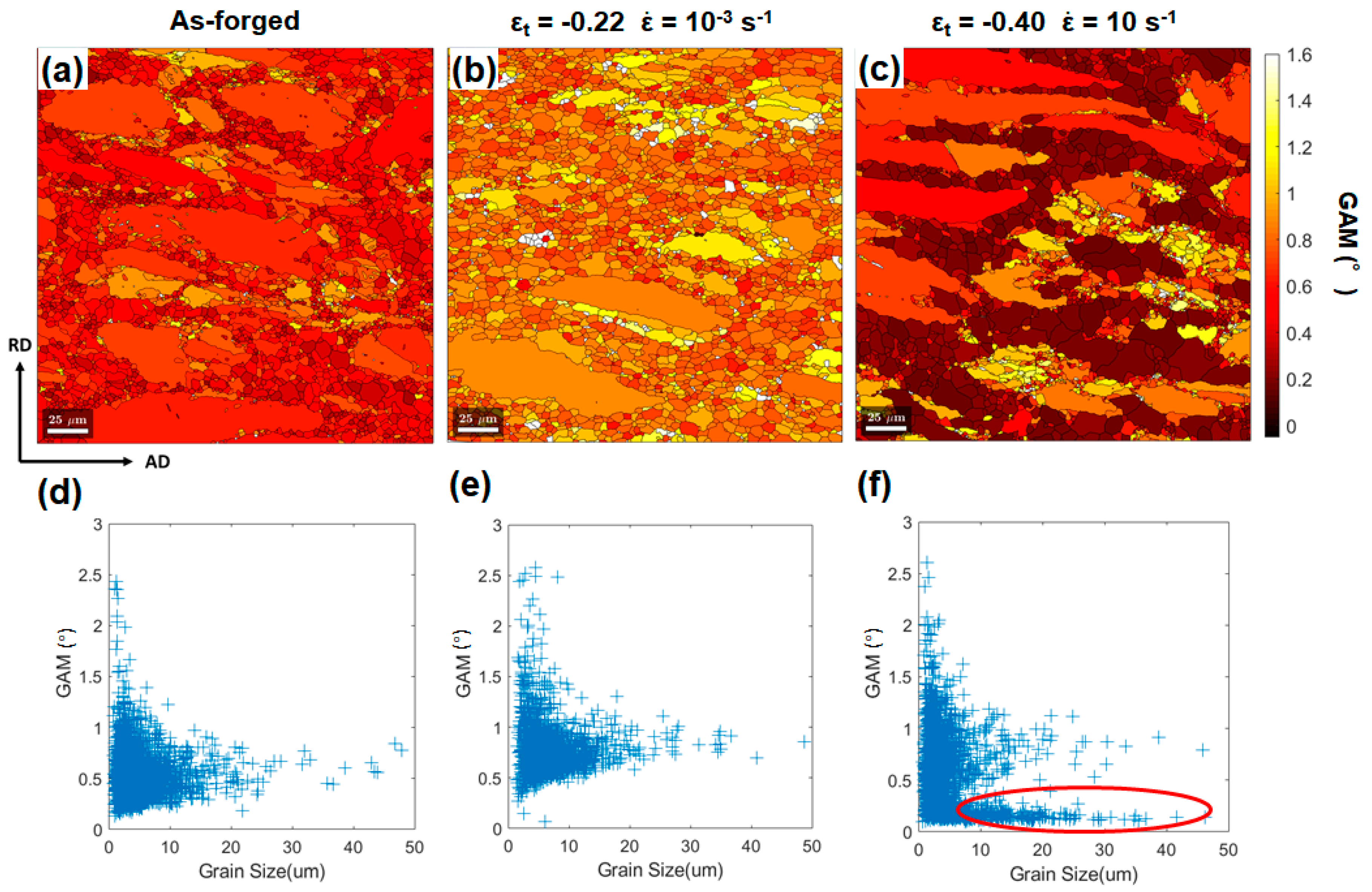
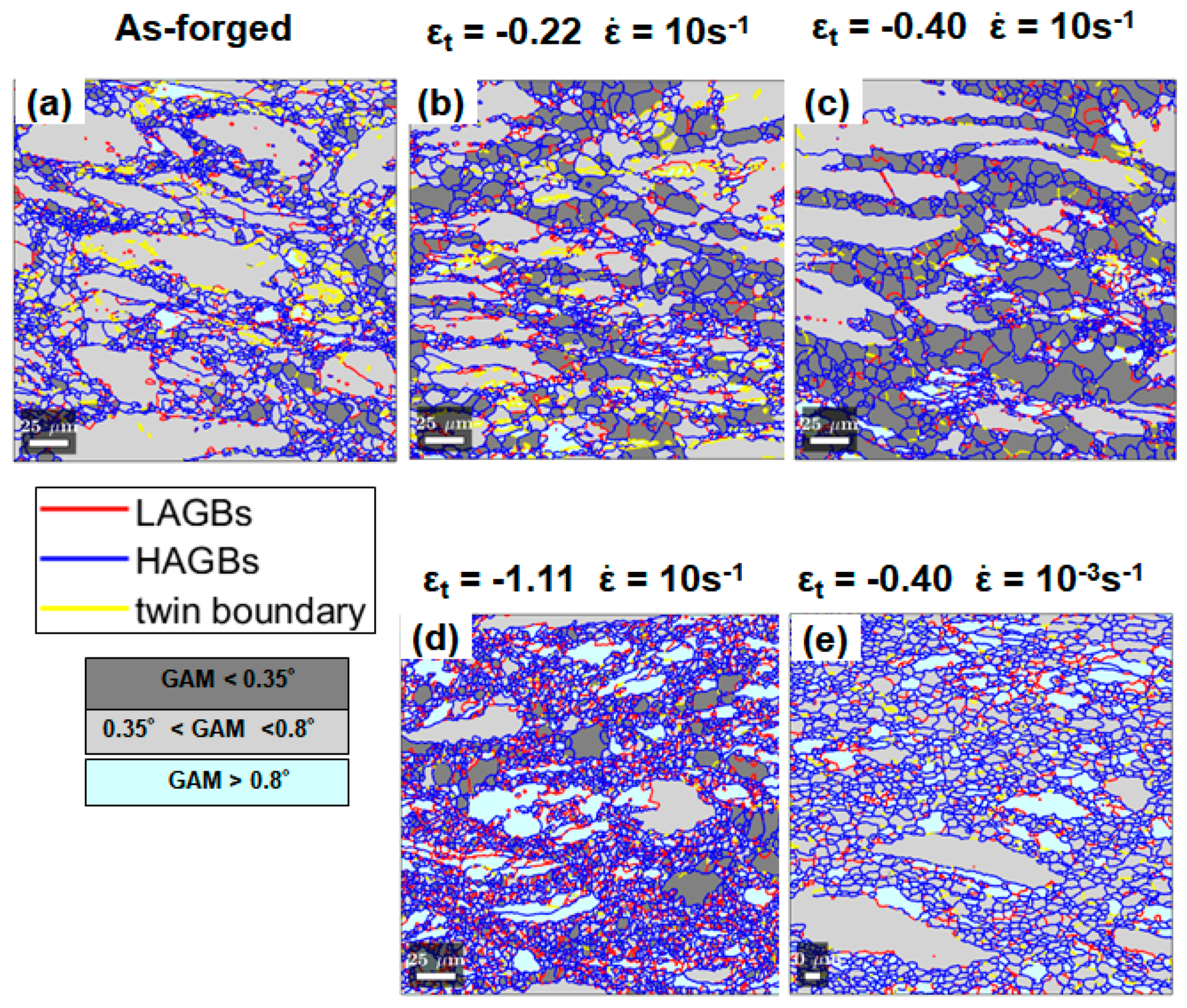
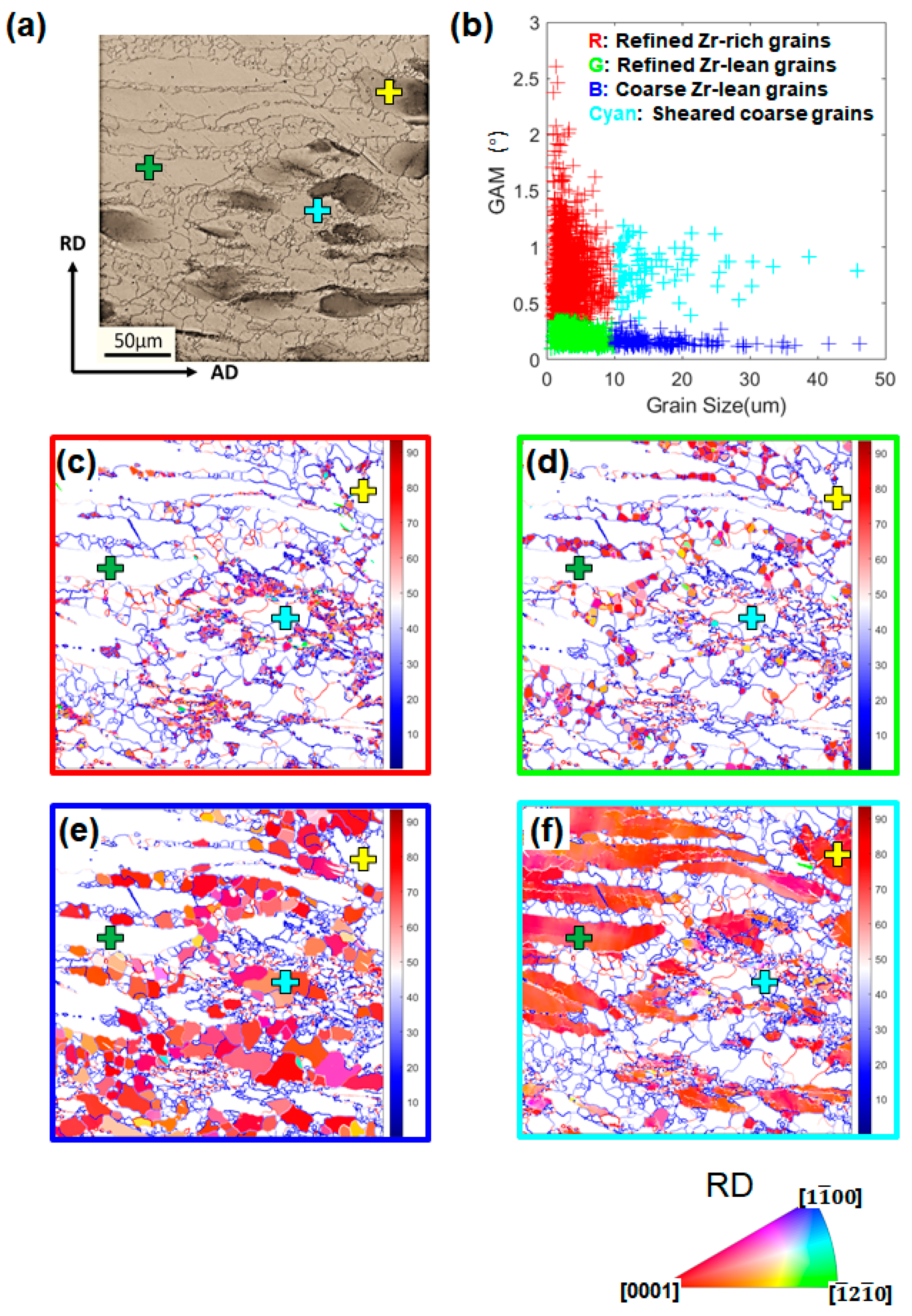

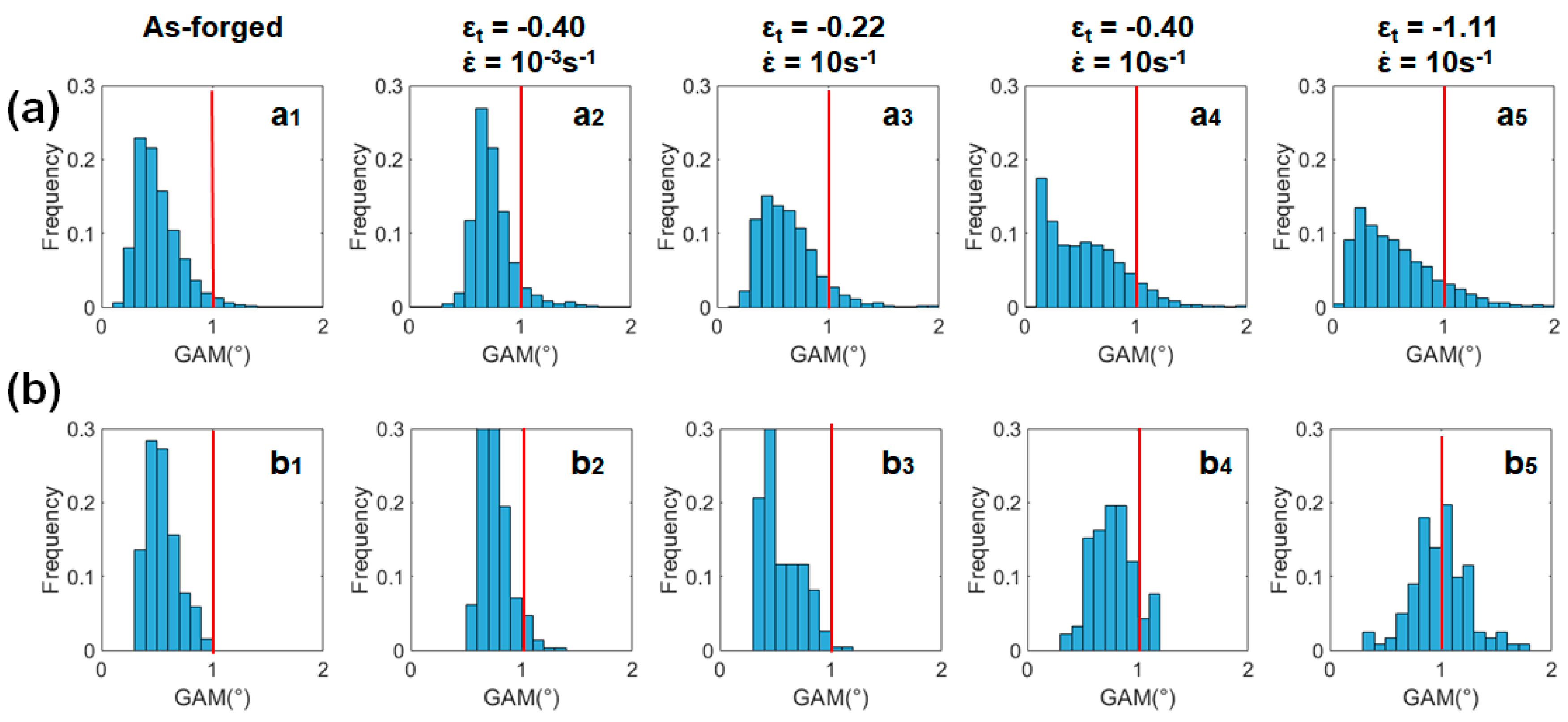
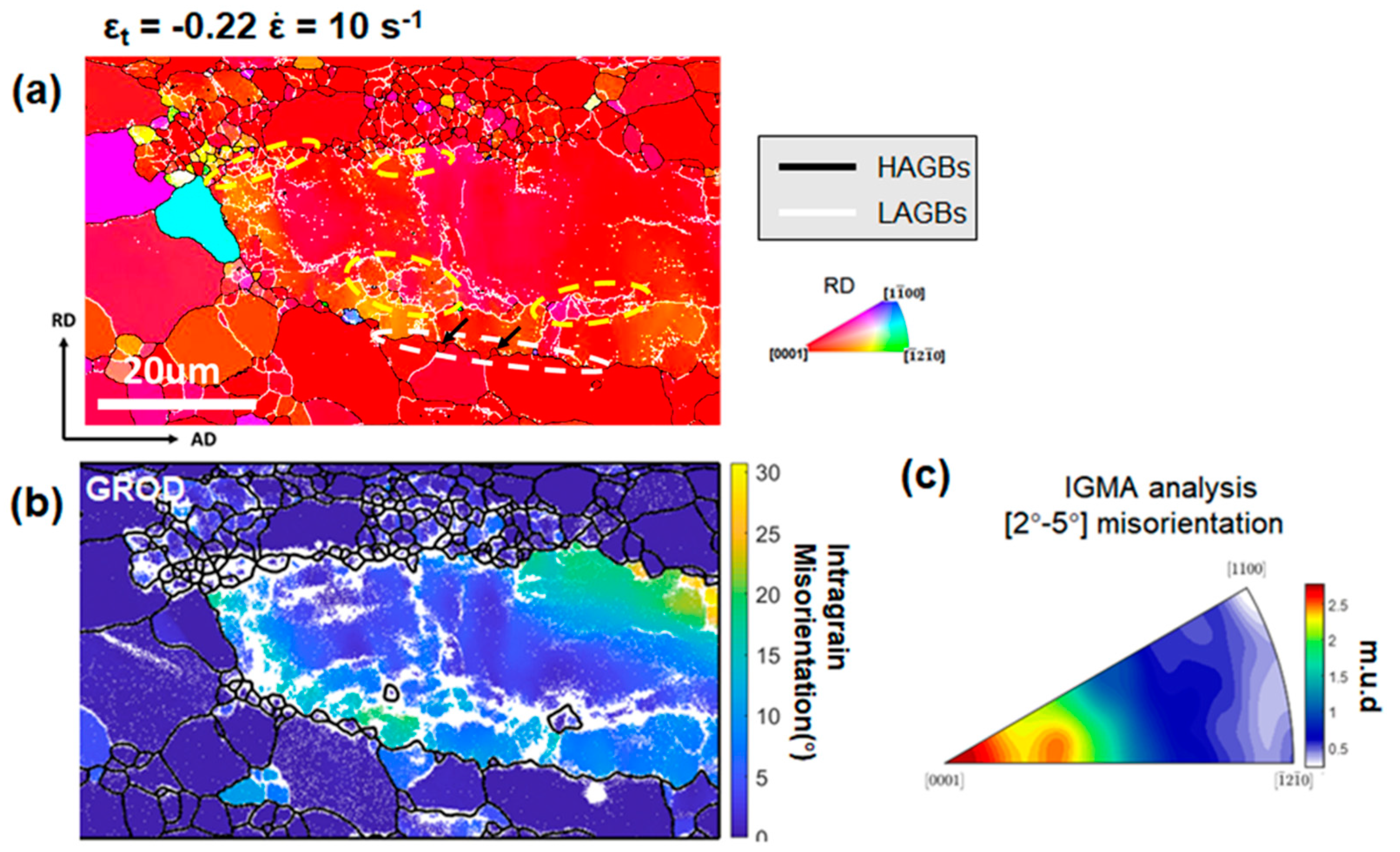
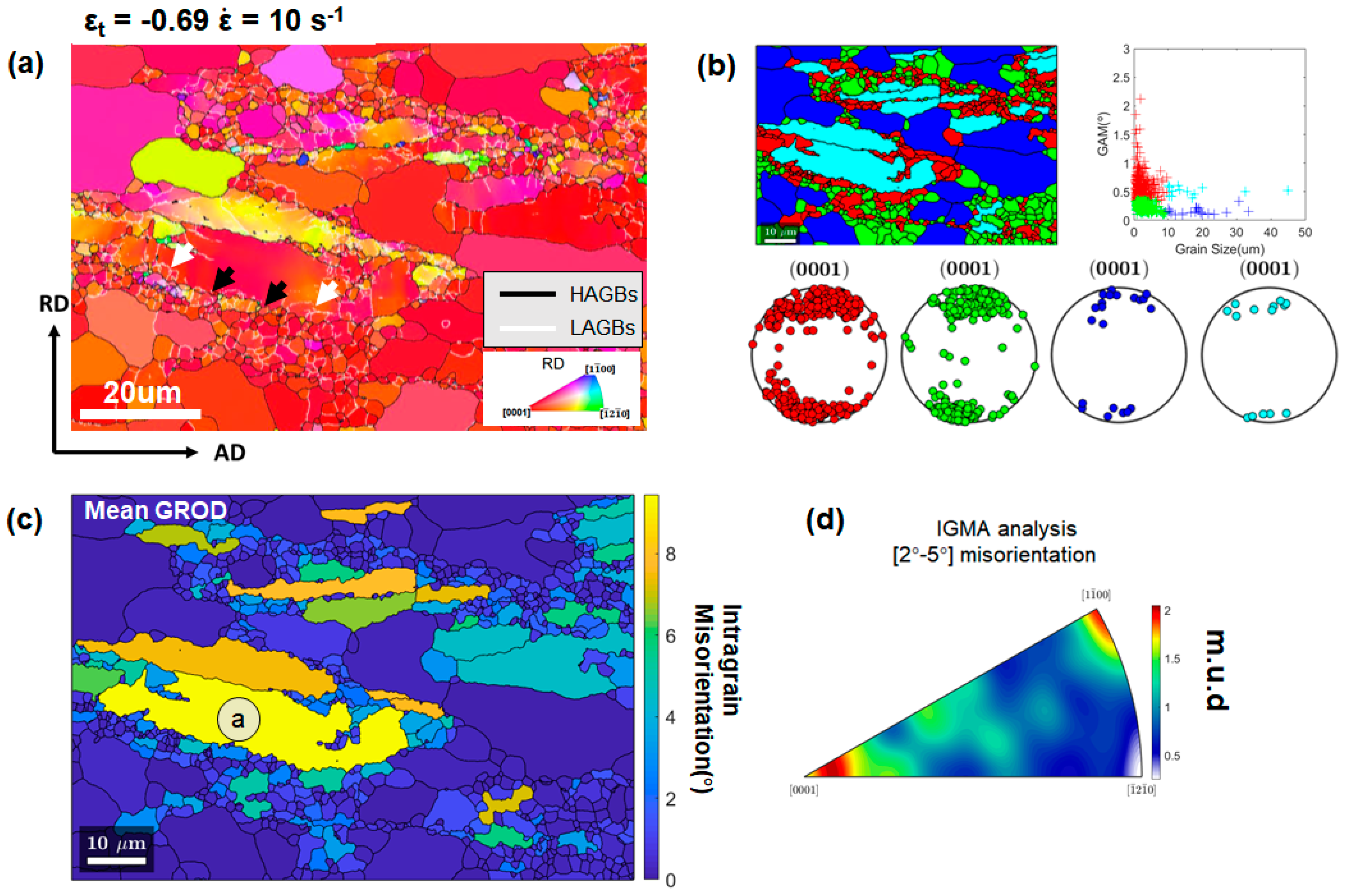
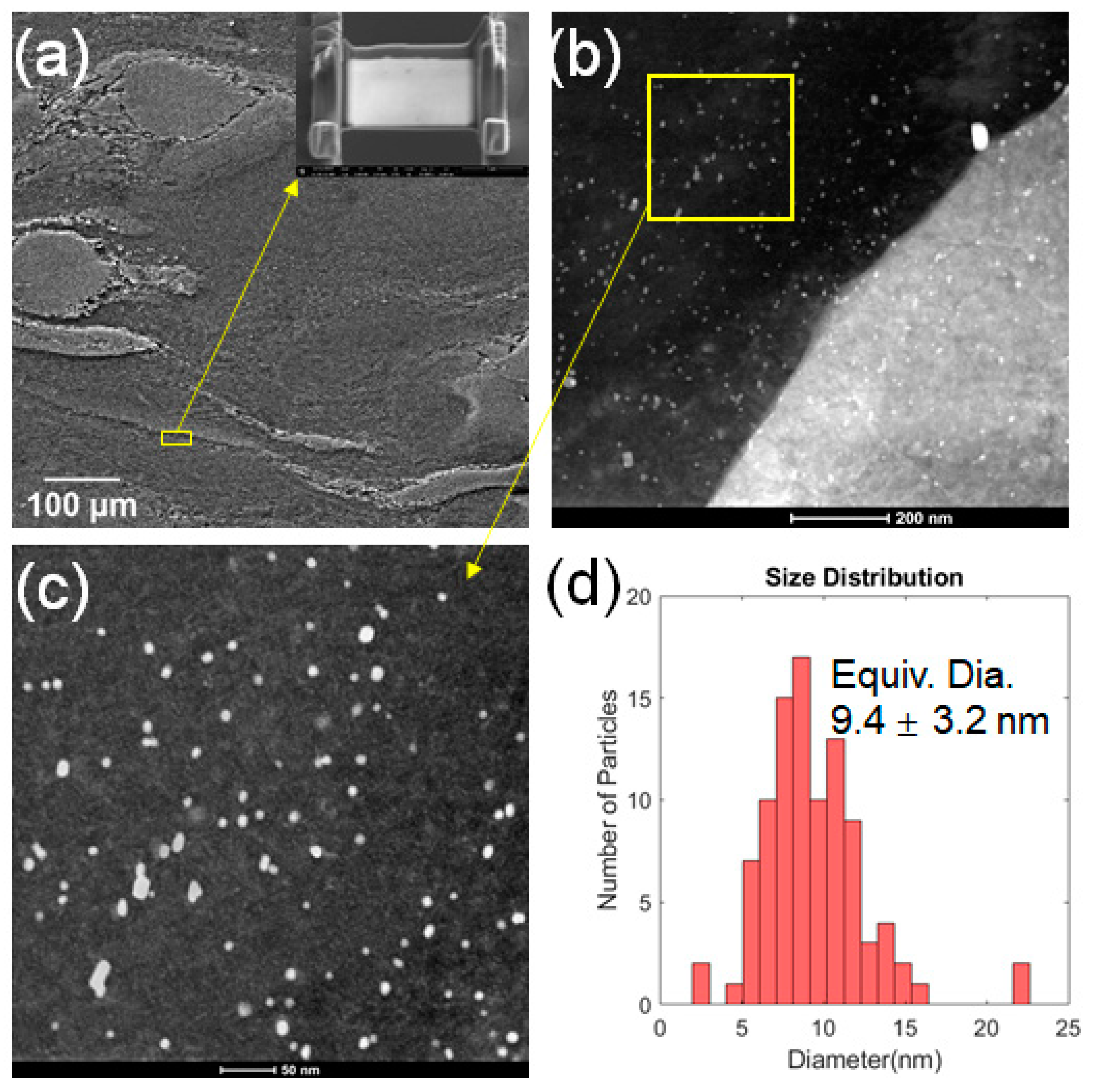
© 2020 by the authors. Licensee MDPI, Basel, Switzerland. This article is an open access article distributed under the terms and conditions of the Creative Commons Attribution (CC BY) license (http://creativecommons.org/licenses/by/4.0/).
Share and Cite
You, J.; Huang, Y.; Liu, C.; Zhan, H.; Huang, L.; Zeng, G. Microstructural Study of a Mg–Zn–Zr Alloy Hot Compressed at a High Strain Rate. Materials 2020, 13, 2348. https://doi.org/10.3390/ma13102348
You J, Huang Y, Liu C, Zhan H, Huang L, Zeng G. Microstructural Study of a Mg–Zn–Zr Alloy Hot Compressed at a High Strain Rate. Materials. 2020; 13(10):2348. https://doi.org/10.3390/ma13102348
Chicago/Turabian StyleYou, Jing, Yingjie Huang, Chuming Liu, Hongyi Zhan, Lixin Huang, and Guang Zeng. 2020. "Microstructural Study of a Mg–Zn–Zr Alloy Hot Compressed at a High Strain Rate" Materials 13, no. 10: 2348. https://doi.org/10.3390/ma13102348
APA StyleYou, J., Huang, Y., Liu, C., Zhan, H., Huang, L., & Zeng, G. (2020). Microstructural Study of a Mg–Zn–Zr Alloy Hot Compressed at a High Strain Rate. Materials, 13(10), 2348. https://doi.org/10.3390/ma13102348




